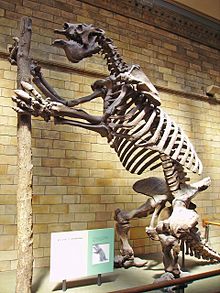
Kingdom: Animalia
Phylum: Chordata
Class: Mammalia
Order: Pilosa
Family: Megatheriidae
Genus: Megatherium
Species: M. amerucanum
M. medinae
M. istilarti
M. parodii
M. sundti
M. gallardoi
Temporal Range: Middle Pliocene to Early Holocene
Megatherium was a genus of ground sloths endemic to South America that lived from the Middle Pliocene through the end of the Pleistocene. Megatherium means great beast. Its size was exceeded by only a few other land mammals, including mammoths and paraceratherium.
The first fossil specimen of this creature was discovered in 1788 by Manuel Torres, on the bank of the Lujan river in Argentina.
Evolution
During the Pliocene, the Central American Isthmus formed, casing the Great American Interchange, and a mass extinction of much of the South American megafauna. Ground sloths were largely unaffected and continued to thrive in spite of competition from the northern immigrants. Ground sloths among the various South American animal groups to migrate northwards into North America, where they remained unflourished until the Late Pleistocene.
Promegatherium is suggested as the ancestor of Megatherium. The oldest species of Megatherium is M. altiplanicum of Pliocene. It was very similar to Promegatherium and was also about the same size. M. tarijense has been regarded as a medium-sized Megatherium species, larger than M. altiplanicum but smaller than M. americanum. It roamed from Bolivia to Peru. Species of Megatherium became larger over time with largest species M. americanum of the late Pleistocene. It was about the size of an African Elephant.

Description
Megatherium weighing up to 4 tonnes and mesuring up to 6 m in length from head to tail. It is largest known ground sloth and would have only been exceeded in its time by a few species of mammoth. It has a robust skeleton with a large pelvic girdle and a broad muscular tail. Its large size enabled it to feed at heights unreachable by other contemporary herbivores. It could support its massive body weight while using the curved claws on its long forelegs to pull down branches with the choicest leaves. Studies also suggest that it had adaptations to bipedalism. Some experts believe that its jaw may have housed a long tongue which it would use to pull leaves into its mouth, similar to the modern tree sloth.It was well adapted for strong predonimatly orthal movement for eating rough vegetation. It was a selective eater.



Habitat
Megatherium inhabited woodland and grassland environment of the lightly wooded areas of South America where it was an endemic species, as recently as 10000 years ago. According to the fossil study, it is believed that they were adaptable to temperate, arid or semiarid open habitats.Behavior
The giant ground sloth lived mostly in groups, but it may have lived singly in caves. It probably had mainly a browsing diet in open habitats, but also it probably fed on other moderate to soft tough food. For millions of years, the sloth did not have many enemies to bother it, so it was probably a diurnal animal.Predators
Because of its size and its deadly claws there are not much predators of this sloth. Though from some studies it is come to know that the Saber tooth cats took sloths as their diet. Now another recent research also indicates that Saber tooth cat also hunt in the lands of South America. So it is very much likely that the saber tooth cat is may be the only predator that have a chance against this massive creature.Diet
They were herbivore animal; feeding on leaves such as yuccas, agaves and grasses. While it fed chiefly on terrestrial plants, it could also stand on its hind legs, using its tail as a balancing tripod. and reach for upper growth vegetation. The sloth's stomach was able to digest coarse and fibrous food. It is likely that it spent a lot of time resting to aid digestion.

No comments:
Post a Comment